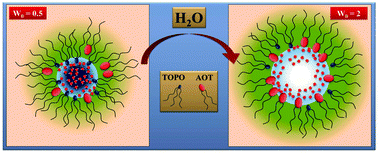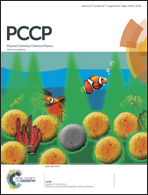How TOPO affects the interface of the novel mixed water/AOT:TOPO/n-heptane reverse micelles: dynamic light scattering and Fourier transform infrared spectroscopy studies†
Abstract
In this work we report for the first time the formation of two reverse micelle (RM) media produced by the nonionic surfactant tri-n-octyl phosphine oxide (TOPO) in n-heptane and the one produced by mixing the anionic sodium 1,4-bis-2-ethylhexylsulfosuccinate (AOT) with different TOPO contents dissolved in n-heptane. Dynamic light scattering (DLS) experiments reveal the formation of water/TOPO/n-heptane RMs (TOPO RMs) and water/AOT:TOPO/n-heptane RMs (mixed RMs) since the droplet sizes increase as the water content increases. The addition of TOPO to the system at constant W0 (W0 = [water]/([AOT] + [TOPO])) causes the droplet sizes of mixed RMs to decrease compared with the AOT RMs. In addition, the decrease is larger when the water content is low (W0 = 0.5) but the effect is negligible at the maximum W0 value analyzed (W0 = 2). These results are not expected for mixtures of different nonionic surfactants with AOT and were explained considering the unique TOPO structure. Thus, at W0 = 0.5, we suggest that the percentage of TOPO molecules at the mixed RM interface is higher than those corresponding to the bulk solution. On the other hand, at W0 = 2 the RM interface is comprised mainly of AOT molecules. The FT-IR experiments performed by monitoring monodeuterated water frequency (νOD) in TOPO RMs show bound and “bulk-like” water structure even at very low water content. On the other hand, for mixed RMs the water structure depends on the water content. At low W0 value, there are two kinds of water molecules, and at W0 value around 2 only bound water exists. The Fourier transform infrared (FT-IR) experiments performed on the symmetric (νsSO3) and asymmetric (νaSO3) sulfonate stretching bands of AOT reveal the existence of a strong Na+˙TOPO complex in the mixed RMs. The results show that adding TOPO to form mixed surfactant RMs with AOT reduces their size, changes the nature of water to have a “bulk-like” character and diminishes the ion pairing of the sulfonate group with Na+.


 Please wait while we load your content...
Please wait while we load your content...